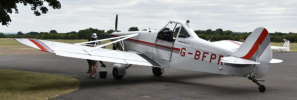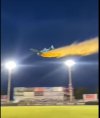As someone who owns and flies a PA-25-235 Pawnee for aerial application, I’d like to clarify a few things:
1) A Pawnee 235 usually reaches its gross weight with around 100-110 gallons of water (8.3 pounds per gallon) and proportionately less with many ag chemicals that can weigh 9 to over 11 gallons per gallon. Most ag pilots who fly or flew Pawnees don’t advise flying with any more than 90-100 gallons. Mine has an updated 260 Hp engine, and while it has ample power to come out of a field and maintain speed in a turn, it’s still short of wing area. With more than 100 gallons (or 830 pounds) in the hopper, the stall speed starts to get uncomfortably close to the accelerated stall speed in a 45 degree turn. My Pawnee with myself and 41 gallons of fuel reaches its gross weight with 107 gallons of water. That last 50 gallons of hopper capacity is only useful for seeding and other operations with lower density dry materials. In short, the weight change was at most on the order of 800 pounds rather than 1200 pounds.
2) A Pawnee with a load and spray equipment will do a maximum of about 105-110 mph at 75% power and even at full power would be unlikely to exceed its Va of 120 mph. My Pawnee 235 has an updated engine producing 260 hp but with its fixed pitched propeller my Pawnees still won’t exceed Va with a full load and spray equipment. Based on both its plying traits and what I see in the video, I don’t see any indication of excessive airspeed in this video.
3) Most ag planes do pitch up during an emergency dump. Ag pilots, like fire pilots flying ag aircraft as single engine air tankers, use forward stick to offset this pitch up tendency and can do it with no pitch up being evident. Students attending ag schools do emergency dumps as part of their part 137 training and very few anticipate the pitch up quickly enough and/or with enough forward stick in Pawnees and in aircraft that pitch up more than a Pawnee but the wings don’t fall off.
4) The Pawnee’s pitch up tendency is comparatively mild, even when dumping a full load. When dumping a full 100-110 gallon load an uncorrected pitch up is still only on the order of 1.5-2.0 G.
5) More to the point, if you don’t mitigate the pitch up with forward stick it looks just like the Pawnee in the video prior to the pitch up. The initial pitch up before the wing separation isn’t out of the ordinary. Even if the pilot added back pressure to make it more spectacular, it’s not a pull anywhere near the damage and failure limits on the VG diagram, even 800 pounds below gross weight. You did discuss the 1995 AD that required periodic and extensive (wing removal and dye penetrant testing) every 24 months, or new wing attach fittings and repetitive replacement every 60 months. Later there were three STCs for new wing attach fittings, two of which retired the AD. Most Pawnees still out there have been modified with the new STC’d attach fittings at some point since 1995 when they have been rebuilt and recovered. The problem is unless you know what you are looking for and look to ensure the new STC’d attach fittings were actually installed, you have no idea if the AD was complied with or just pencil whipped. Similarly there is no way to know whether a 24 month or 60 month inspection was actually done if the aircraft has the original fittings. It’s not a common issue in the US, but Bic maintenance is a bigger potential issue south of the border, where these wing separations happen.

 www.thesun.co.uk
www.thesun.co.uk





